Note: This website was automatically translated, so some terms or nuances may not be completely accurate.
Isn't it true that things are more interesting when the restraints are off?
Rika Eguchi is an up-and-coming creator handling diverse art direction, from apparel brands to music visuals for artists like Kaela Kimura. With a uniquely feminine, supple sensibility, she consistently produces designs that are somehow alluring and full of vitality. Where does the unique "essence" and worldview common to Ms. Eguchi's work come from? We asked her about the values she cherishes, her specific creative methods, and how raising her two children has changed her.

The goal is to surpass imagination
――Your work seems imbued with a unique power, a kind of allure and vitality. Where does this style originate?
Eguchi: Hmm, I'm not entirely sure about that impression myself... But I always start by creating things I personally want to see. No matter the project, my goal is to exceed expectations. I aim to go beyond the brief, to make people think, "Wow, this product is actually this interesting!" or "It can look this beautiful!" When everyone—clients and staff alike—is excitedly wondering how it will turn out, that's when great things tend to happen.
And when brainstorming ideas, I consciously try to forget all the constraints—budget, production schedule, everything. I even forget I'm an employee of a company, or that what I'm making is advertising (laughs). Because when you let go of those restraints, more interesting things happen, right? Rather than starting with the mindset that "this is advertising," I think it's better to focus purely on conveying the product's appeal.
I pour everything into things I "want to see" or "feel worth investing time in." While I consciously avoid trying to create a specific style or color palette, perhaps this approach itself is what leads to a sense of "authenticity."
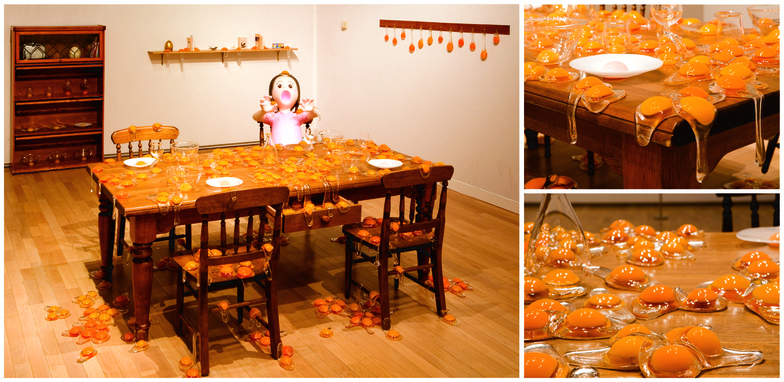
What does it mean to overturn the ordinary?
――More than just your work, I sense an extraordinary vitality within Eguchi-san yourself. Are there specific things you do to realize those thoughts and feelings?
Eguchi: My passion often serves as the engine. I can push myself because I love both making things and family life. Conversely, I can't muster any effort for things that don't interest me (laughs). So, I'm not constantly bursting with vitality; I'm actually quite lazy and, if anything, the type who'd rather sleep all day (laughs).
But when it comes to work, I want to pour passion into it. I truly believe that passion always resonates with people. Regardless of the type or scale of the job, I want to find an idea I can get completely absorbed in. So I take time to think it through, or if creating lots of visuals makes it more interesting, I'll work hard on that. I strive to elevate it to a point where people who see it think, "Wow, this is amazing."
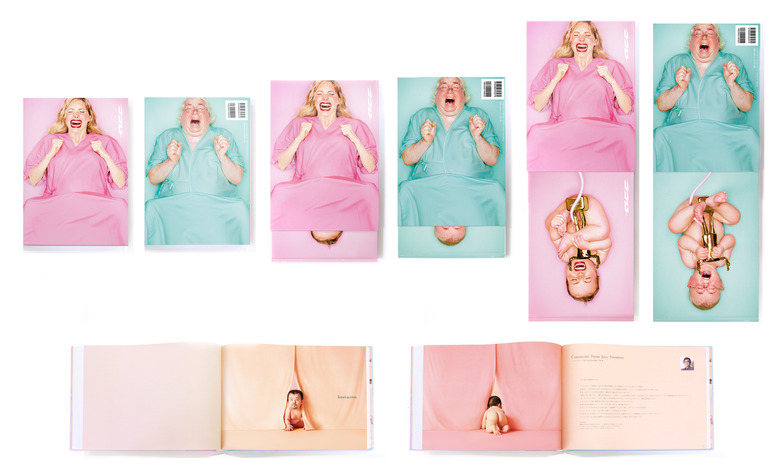
Another key point is questioning the obvious. When branding the fashion label "KOE," I deliberately imposed a constraint: having the models appear with their eyes closed. In portrait photography, shots with closed eyes are generally considered unacceptable. But this brand was eco-conscious, genuinely committed to facing the Earth's environment and one's inner voice, with the tagline "Listen to my voice." So I proposed that all models wearing "KOE" clothing should close their eyes to listen to their inner voice. Sometimes questioning common sense or rules, or even turning them on their head, can lead to expressions we've never seen before or even better expressions.
Also, while eco-themed shoots often take place outdoors, we consciously "shift things slightly off-center" – like deliberately setting up a studio with painted sky backdrops. We express nature, but by shifting just one element, we aim to create the brand's originality and a sense of fashion, generating a subtle dissonance that draws the eye.
I find it easier to shift things that are widely known or taken for granted. Shifting them creates a moment of surprise, prompting new insights. I believe accumulating these kinds of creative efforts can ultimately change the viewer's perspective.
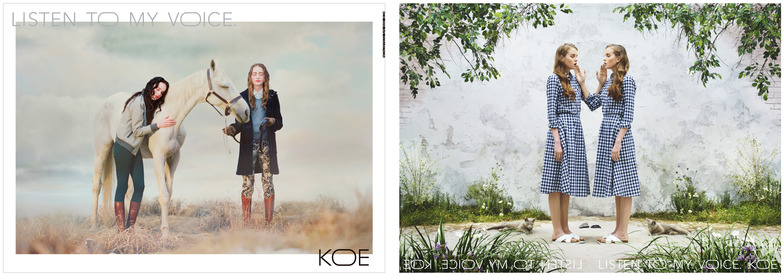
Left: KOE's 2014AW ad. An outdoor landscape was created inside the studio, with models and animals alike depicted with closed eyes.
Right: KOE's Spring 2016 ad. A symmetrical set was built inside the studio, creating a space reminiscent of a tranquil, introspective landscape. Twin models were used to express the act of listening to one's inner voice. This visual successfully conveys the brand's unique positioning as fast fashion that prioritizes environmental consideration.
After experiencing childbirth and raising children, I began wanting to do work that connects to people's joy.
――Ms. Eguchi, you're also a working mother raising two children while pursuing your career. Did your approach to work or your mindset change before and after giving birth?
Eguchi: It changed dramatically. Before giving birth, I think I spent all day thinking only about work. I enjoyed it so much that weekends, nights, it didn't matter—I was always thinking, "Let's try this, let's try that," and work never left my mind (laughs). I think that period was good, but after having children, I started making a conscious effort not to work on weekends and to clearly separate my on and off time.
After that, I faced the daycare problem and struggled with the difficulty of balancing childcare and work—I hit every single wall everyone else hits. Precisely because things rarely go as planned, I've come to truly appreciate ordinary days and cherish daily life more than ever before.
Another change was that I started wanting to create expressions that warm people's hearts, not just rely on visual impact. My desire to be involved in enriching people's lives grew stronger, leading to projects like designing materials for Benesse's Kodomo Challenge Baby program and creating my book 'The Bread King,' published by Shogakukan.


――How do you balance work and family life? Do you have specific strategies, like setting fixed work hours?
Eguchi: I don't set things too rigidly. The standardized examples of balance promoted by the government or companies don't necessarily fit my family situation or job type. I try to find balance through customization unique to my household. To keep the creative engine running, I returned to work relatively soon after giving birth, taking it easy at first. My husband and I work in tandem: one half the week I work overtime, the other half I leave on time. If I'm away for a week on an overseas shoot, I make sure to be the one supporting the family the following week. We don't stick rigidly to a plan; we adjust based on work demands and family needs.
Ads are completed in a few months, but children and family take years, even decades, to nurture. I think it's like the Sagrada Familia—a project that's never truly finished (laughs). That's precisely why it's interesting and rewarding. I believe it's crucial to approach it with a long-term perspective, being flexible and learning through trial and error.
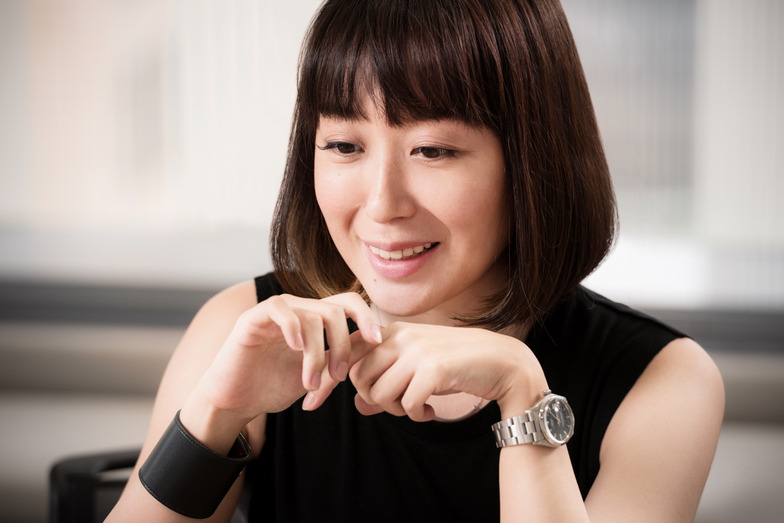
――Is there any work you could only do because you gave birth?
Eguchi: There are many, but working on Kaela Kimura's song "EGG" was particularly memorable. It was a request for the jacket design of the insert song "37.5℃ no Namida" (Tears at 37.5°C) for a drama about sick child care. The request came just as I was taking my second son, who had a fever, to sick child care (laughs), so I remember it being incredibly timely. I art directed the whole project, combining Kaela-san's edgy presence with immense love, aiming for all troubled people holding onto important things, including childcare, to be able to break out of their shells.
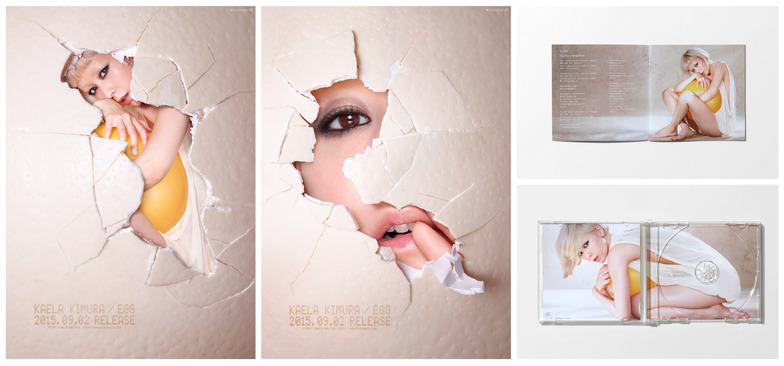
I believe all experiences, not just childbirth and parenting, become tools in my creative toolbox. Kaela-san knew about my glass egg artwork from my student days and suggested using an egg motif this time, leading to the visual concept. That's how everything connects—past works, childhood experiences, love, work, hobbies, setbacks. It all links together like the straw millionaire's tale.
Once I realized that no experience is wasted, I stopped fearing new ventures or failure.
Moving forward, I want to create more things that connect to the joys of people's lives. Someday, I'd love to create an amusement park or theme park. People gathering around the work, each weaving their own memories and stories... That kind of development feels similar to raising children, and I think it's the ultimate form of creativity. I dream of seriously creating an amusement park itself someday, not just advertising for one!
Was this article helpful?
Newsletter registration is here
We select and publish important news every day
For inquiries about this article
Author

Rika Eguchi
Dentsu Inc.
CDC
Art Director
While working as an art director at Dentsu Inc., he also exhibits his work as an artist both domestically and internationally. His picture book "The Bread King" was published in 2014. His activities span various fields including advertising, art, product design, and costume design—such as designing costumes for figure skater Daisuke Takahashi in 2012.